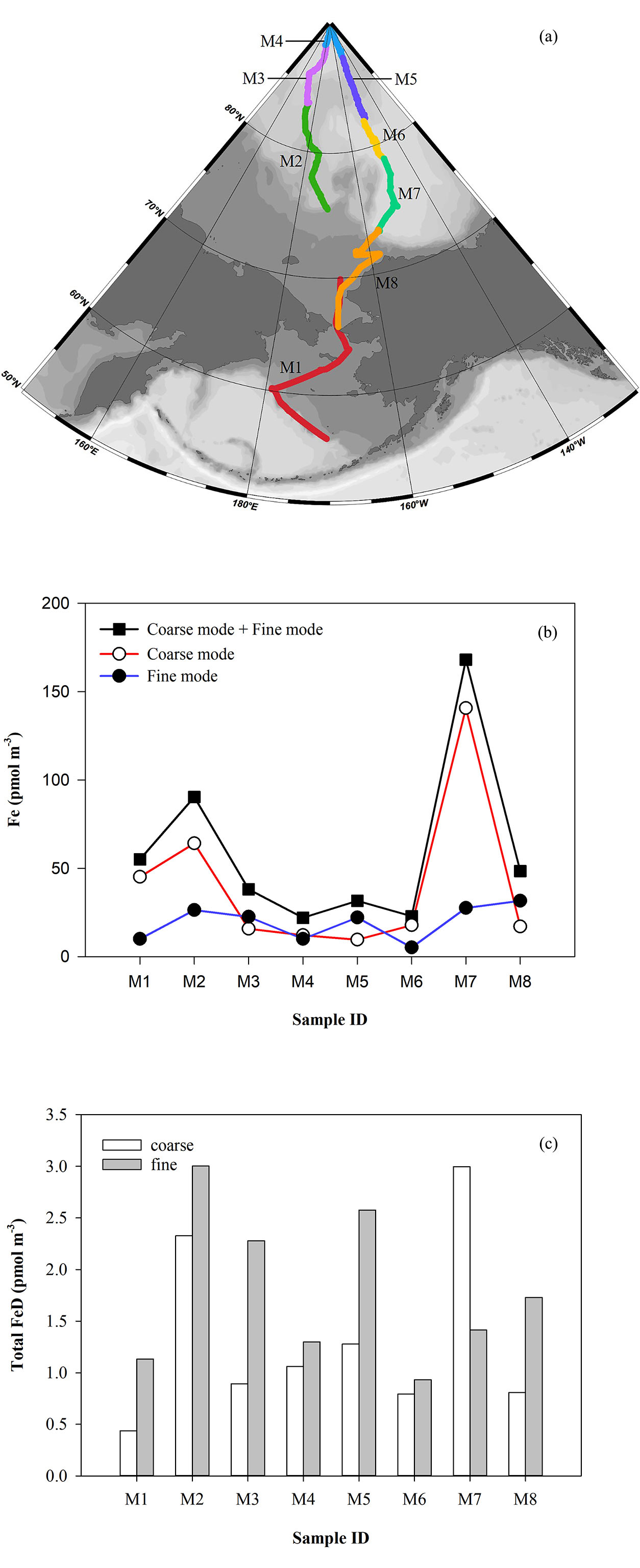A unique insight into the properties of iron aerosols in the Arctic Ocean
Gao and co-workers (2019, see reference below) collected size-segregated aerosols over 8 segments of the 2015 US GEOTRACES cruise (GN01) across the Arctic Ocean. They show that:
- aerosol iron (Fe) had a single-mode size distribution, peaking at 4.4 μm in diameter, suggesting regional dust sources of Fe around the Arctic Ocean,
- Fe in the coarse-mode particles accounted for ~68% of the aerosol Fe from all samples and 59% if sample M7 is excluded,
- the low Fe/Ti ratio indicate that Fe was not enriched relative to average upper continental crust,
- although the less abundant fraction, the fine dusts (<1µm) contain the most dissolvable fraction of iron but abundant organic ligands are also suspected to increase the Fe solubility and,
- dry deposition rates of aerosol Fe decreased from 6.1 μmol m−2 yr−1 in the areas of ~56°N–80°N to 0.73 μmol m−2 yr−1 in the areas north of 80°N.
 Figure: (a) Cruise tracks showing the coverage of eight sets (M1 – M8) of aerosol samples collected in the Arctic Ocean aboard the US Coast Guard Ice Breaker Healy during the period from 9th August 2015 to 12th October 2015. (b) Spatial variation of atmospheric concentrations of aerosol Fe in fine- and coarse-mode particles and total (coarse + fine) particles. Higher concentrations of aerosol Fe in samples M2 and M7 likely resulted from dust materials transported from nearby continental areas. (c) Atmospheric concentrations of total dissolvable Fe in fine aerosols were higher than those in coarse aerosols. One explanation is that smaller aerosols may provide larger surface areas relative to their volume for chemical reactions with other substances that promote Fe dissolution from dust. Click on the figure to view it larger.
Figure: (a) Cruise tracks showing the coverage of eight sets (M1 – M8) of aerosol samples collected in the Arctic Ocean aboard the US Coast Guard Ice Breaker Healy during the period from 9th August 2015 to 12th October 2015. (b) Spatial variation of atmospheric concentrations of aerosol Fe in fine- and coarse-mode particles and total (coarse + fine) particles. Higher concentrations of aerosol Fe in samples M2 and M7 likely resulted from dust materials transported from nearby continental areas. (c) Atmospheric concentrations of total dissolvable Fe in fine aerosols were higher than those in coarse aerosols. One explanation is that smaller aerosols may provide larger surface areas relative to their volume for chemical reactions with other substances that promote Fe dissolution from dust. Click on the figure to view it larger.
Reference:
Gao, Y., Marsay, C. M., Yu, S., Fan, S., Mukherjee, P., Buck, C. S., & Landing, W. M. (2019). Particle-Size Variability of Aerosol Iron and Impact on Iron Solubility and Dry Deposition Fluxes to the Arctic Ocean. Scientific Reports, 9(1), 16653. https://doi.org/10.1038/s41598-019-52468-z
